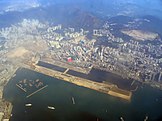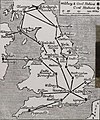Portal:Aviation
| Main page | Categories & Main topics |
|
Tasks and Projects |
The Aviation Portal

Aviation includes the activities surrounding mechanical flight and the aircraft industry. Aircraft includes fixed-wing and rotary-wing types, morphable wings, wing-less lifting bodies, as well as lighter-than-air craft such as hot air balloons and airships.
Aviation began in the 18th century with the development of the hot air balloon, an apparatus capable of atmospheric displacement through buoyancy. Some of the most significant advancements in aviation technology came with the controlled gliding flying of Otto Lilienthal in 1896; then a large step in significance came with the construction of the first powered airplane by the Wright brothers in the early 1900s. Since that time, aviation has been technologically revolutionized by the introduction of the jet which permitted a major form of transport throughout the world. (Full article...)
Selected article
With numerous skyscrapers and mountains located to the north and its only runway jutting out into Victoria Harbour, landings at the airport were dramatic to experience and technically demanding for pilots. The History Channel program Most Extreme Airports ranked it as the 6th most dangerous airport in the world.
The airport was home to Hong Kong's international carrier Cathay Pacific, as well as regional carrier Dragonair, freight airline Air Hong Kong and Hong Kong Airways. The airport was also home to the former RAF Kai Tak. (Full article...)
Selected image
Did you know
...that among the earliest accounts of the use of a man-lifting kite is in the story of Ishikawa Goemon's robbery from Nagoya Castle? ...that Frenchman Jean-Marie Le Bris accomplished the world's first powered flight in 1856, with a glider that was pulled behind a running horse? ... that the Tony Jannus Award for distinguished achievement in commercial aviation is named for the pilot of the first scheduled commercial airline flight?
General images -
In the news
- May 29: Austrian Airlines cancels Moscow-bound flight after Russia refuses a reroute outside Belarusian airspace
- August 8: Passenger flight crashes upon landing at Calicut airport in India
- June 4: Power firm helicopter strikes cables, crashes near Fairfield, California
- January 29: Former basketball player Kobe Bryant dies in helicopter crash, aged 41
- January 13: Iran admits downing Ukrainian jet, cites 'human error'
- January 10: Fire erupts in parking structure at Sola Airport, Norway
- October 27: US announces restrictions on flying to Cuba
- October 3: World War II era plane crashes in Connecticut, US, killing at least seven
- September 10: Nevada prop plane crash near Las Vegas leaves two dead, three injured
- August 6: French inventor Franky Zapata successfully crosses English Channel on jet-powered hoverboard
Related portals
Associated Wikimedia
The following Wikimedia Foundation sister projects provide more on this subject:
-
Commons
Free media repository -
Wikibooks
Free textbooks and manuals -
Wikidata
Free knowledge base -
Wikinews
Free-content news -
Wikiquote
Collection of quotations -
Wikisource
Free-content library -
Wikiversity
Free learning tools -
Wikivoyage
Free travel guide -
Wiktionary
Dictionary and thesaurus
Selected biography
Selected Aircraft

The Beechcraft King Air is a line of twin-turboprop aircraft produced by the Beech Aircraft Corporation (now the Beechcraft Division of Hawker Beechcraft). The King Air has been in continuous production since 1964, the longest production run of any civilian turboprop aircraft. It has outlasted all of its previous competitors and as of 2006 is one of only two twin-turboprop business airplanes in production (the other is the Piaggio Avanti).
Historically, the King Air family comprises a number of models that fall into four families, the Model 90 series, Model 100 series, Model 200 series, and Model 300 series. The last two types were originally marketed as the Super King Air, but the "Super" moniker was dropped in 1996. As of 2006, the only small King Air in production is the conventional-tail C90GT.
- Span: 50 ft 3 in (15.33 m)
- Length: 35 ft 6in (10.82 m)
- Height: 14 ft 3 in (4.35 m)
- Engines: 2 × Pratt & Whitney Canada PT6A-21 turboprops, 550 shp (410 kW) each
- Cruising Speed: 284 mph (247 knots ,457 km/h)
- First Flight: May 1963
Today in Aviation
- 2009 – RwandAir Flight 205, a Bombardier CRJ-100, crashes into a terminal shortly after an emergency landing at Kigali International Airport, Rwanda; of the 10 passengers and 5 crew, 1 passenger dies.
- 2004 – UH-60A Black Hawk from 1–106th Aviation Regiment shot down northeast of Baghdad, wounding three of the four crew members.[2]
- 2001 – American Airlines Flight 587, an Airbus A300, crashes into a Queens neighborhood in New York City when the plane's vertical tail fin snaps just after takeoff. All 251 passengers and nine crew members on board are killed as well as five people on the ground.
- 1996 – Charkhi Dadri mid-air collision: Saudi Arabian Airlines Flight 763, a Boeing 747, collides in mid-air with Air Kazakhstan Flight 1907, an Ilyushin Il-76, near Charkhi Dadri, India. All 312 on board the Boeing 747 and all 37 on board the Ilyushin Il-76 are killed.
- 1995 – American Airlines Flight 1572, a McDonnell Douglas MD-83 with 78 people on board, lands short of the runway at Bradley International Airport in Windsor Locks, Connecticut. Only one person is injured.
- 1995 – Launch: Space Shuttle Atlantis STS-74 at 7:30:43.071 a.m. EST. Mission highlights: 2nd Shuttle-Mir docking. Delivered docking module. IMAX cargo bay camera.
- 1989 – California Polytechnic State University flies the first human-powered helicopter
- 1984 – Space Shuttle astronauts snare a satellite, the first ever “space salvage. ”
- 1983 – McDonnell-Douglas F-15A-16-MC Eagle, 76-076, c/n 0265/A228, of the 71st Tactical Fighter Squadron, 1st Tactical Fighter Wing, jumps chocks during an engine run at Langley AFB, Virginia, and collides with F-15, 76-071, c/n 0259/A223, of the same units. Both are repaired. 76-076 is later placed on display in park near DeBary, Florida, marked as 85-0125, in memory of an airman killed in the Khobar Towers terrorist bombing.
- 1981 – Launch: Space shuttle Columbia STS-2 at 15:09:59 UTC. Mission highlights: First reuse of a manned orbital space vehicle; first test of Canadarm robot arm; Truncated due to fuel cell problem.
- 1980 – Delta Air Lines orders 60 Boeing 757s, the largest single order to this time for a single airliner type.
- 1980 – Voyager 1 makes its closest approach to Saturn, flying 77,000 miles above its surface and taking photo of its rings.
- 1970 – First flight of the Kawasaki C-1
- 1944 – 29 Royal Air Force Avro Lancaster bombers employing 12,000-pound (5,443 kg) Tallboy bombs score two hits on the German battleship Tirpitz at Altenfjord, Norway, sinking her with heavy loss of life.
- 1943 – A strike by five Japanese Mitsubishi G4 M (“Betty”) bombers damages the light cruiser USS Denver (CL-58) off Bougainville.
- 1941 – The British aircraft carrier HMS Ark Royal was torpedoed on 12 Nov 1941 and it sank the following day in the Mediterranean Sea east of Gibraltar by the German submarine U-81.[3][better source needed][4][5][6]
- 1932 – First flight of the de Havilland Dragon
- 1922 – Lt. Cdr. Godfrey DeCourcelles Chevalier, a graduate of the U.S. Naval Academy in June 1910, who was appointed a Naval Air Pilot No. 7 on 7 November 1915 and a Naval Aviator No. 7 on 7 November 1918, crashes in a Vought VE-7 while en route from NAS Norfolk to Yorktown, Virginia, dying in Portsmouth Naval Hospital on 14 November as a result of his injuries. On 26 October 1922 Lieutenant Commander Chevalier made the first landing on the USS Langley's deck, the U.S. Navy's first aircraft carrier, in an Aeromarine 39-B, A-606.
- 1921 – The first air-to-air refueling was made when Wesley May stepped from the wing of one aircraft to that of another carrying a five-gallon can of gasoline strapped to his back.
- 1919 – Keith and Ross Smith set out to fly a Vickers Vimy, G-EAOU, from England to Australia, the first flight between these two places. They arrive in Darwin on December 18.
- 1912 – A Curtiss Triad becomes the first aircraft to be launched by catapult, at the US Navy's Washington Navy Yard.
- 1912 – The first demonstration of naval aircraft at an Imperial Japanese Navy fleet review takes place at Yokohama, with Lieutenant Yōzō Kaneko flying a Farman seaplane and Lieutenant Sankichi Kōno a Curtiss seaplane.
- 1906 – First flight certified and registered by FAI: Brazilian Alberto Santos Dumont in Paris in his “14 bis” flies some 720 feet and wins the Aéro-Club de France prize for exceeding 100 m.
- 1903 – The Lebaudy brothers make a controlled dirigible flight of 54 km (34 miles) from Moisson to Paris.
References
- ^ "US F-16 destroyed in ground fire". 2008-11-12. Retrieved 2009-07-30.
A USAF F-16 (believed to be #93-0554) assigned to the 332nd AEW, based at Joint Base Balad, Iraq, caught fire after the pilot aborted the takeoff, at about 5.40h Baghdad time.
- ^ Robert F. Worth and James Glanz (2004-11-13). "U.S. forces in Fallujah meet more fierce resistance". International Herald Tribune. Archived from the original on 2011-05-17. Retrieved 2009-01-30.
- ^ HMS Ark Royal (91)
- ^ "BBC - WW2 People's War - The sinking of HMS Ark Royal".
- ^ "HMS Ark Royal (1937-1941)".
- ^ "Search | Imperial War Museums".
- Shortcuts to this page: Portal:Airplanes • P:AVIA






















































